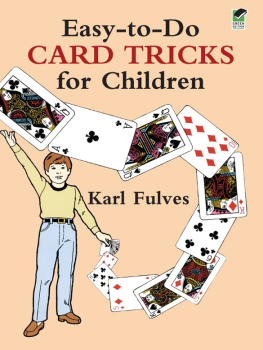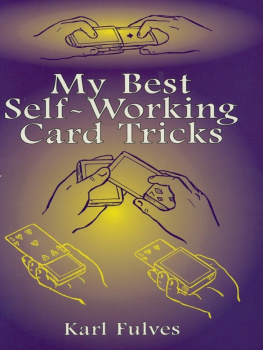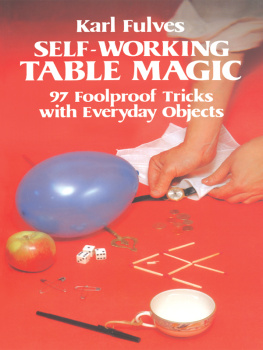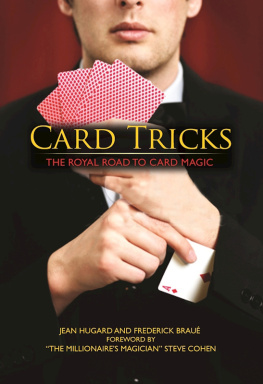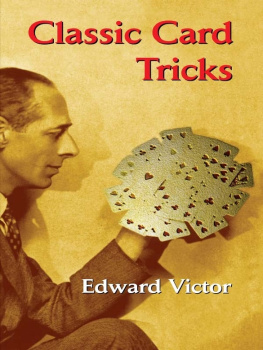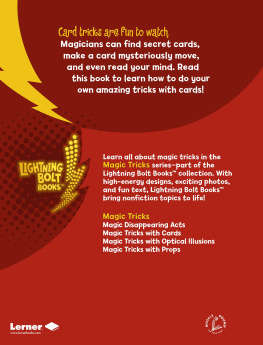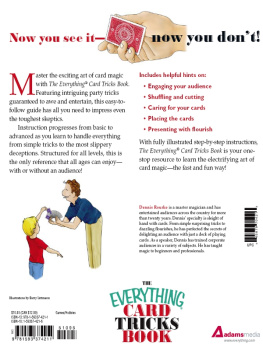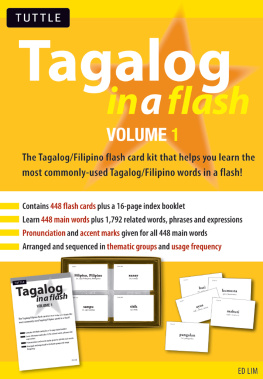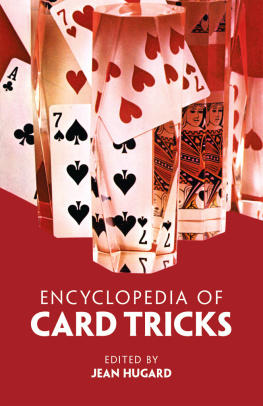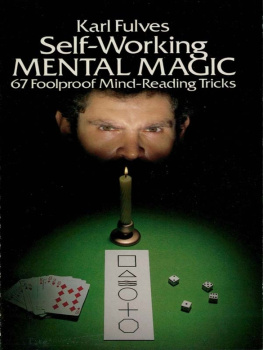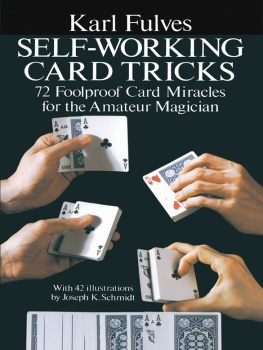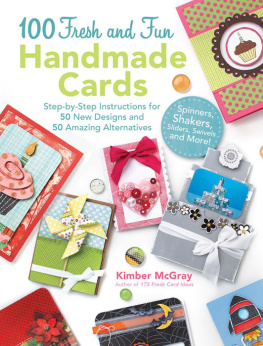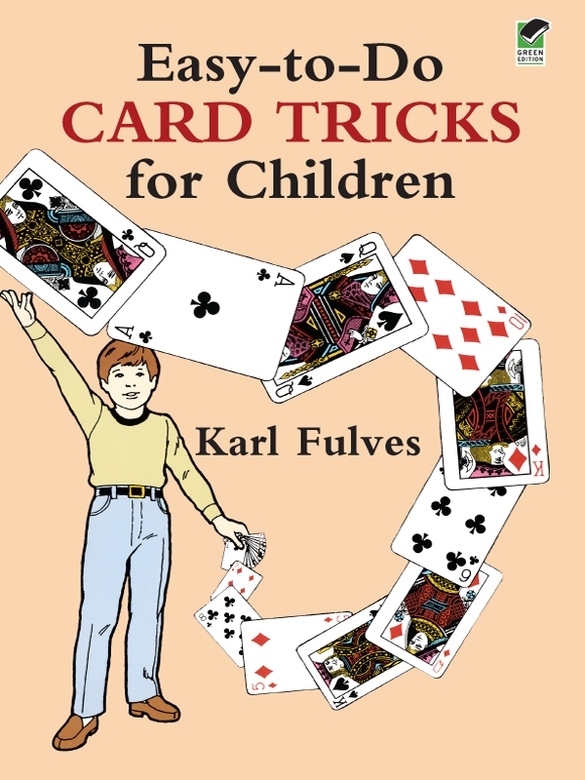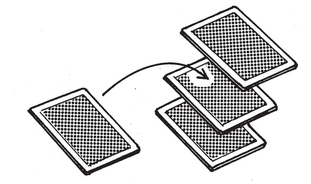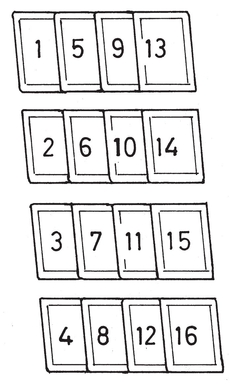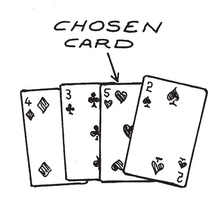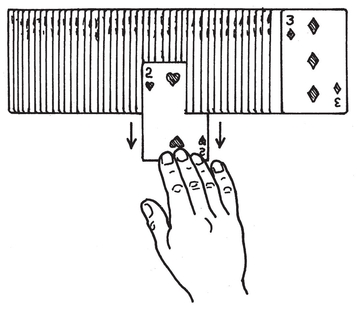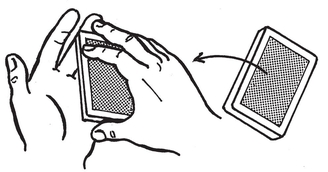Hands Off
The magician takes it easy in this trick. The spectator chooses a card, returns it to the deck and mixes the cards. Without ever touching the pack, the magician reveals the chosen card.
Method: Ask the spectator to remove eight cards from the top of the deck. Tell him to mix the eight cards and choose one.
After the spectator notes the chosen card, he replaces it on top of the deck. Then he places the remainder of the eight-card packet on the deck. At this point the chosen card is eighth from the top of the deck.
Have him cut off about a third of the deck. The exact number of cards is not important as long as the packet contains more than ten cards.
The spectator holds the cut-off packet in his hand. With his other hand he places the top card of the packet under the packet. Then he places the next card on the table.
He places the next card under the packet. Then he places the next card on top of the card that is on the table. He continues this way, dealing under-down-under-down, until all of the cards have been dealt down onto the heap on the table.
Ask him to spread the packet face up on the table. When you look at the faces of the cards, note the card that lies fourth from the face. It is shown by the arrow in the example of . This is the chosen card.
Do not reveal it yet. Close your eyes, pretend to receive mystic vibrations from the deck, then reveal the color, suit and value of the chosen card. In the example of you would say, Your card is red, a heart. Yes, I can see it clearly, the eight of hearts.
Infallible
Prediction tricks hint that the magician can see the future. To demonstrate this, the spectator mixes face-up and face-down cards together. Then he divides the cards into two heaps. Each heap contains some face-up cards and some face-down cards.
Taking one heap behind his back, the magician makes an adjustment so that the number of face-up cards in his heap correctly predicts the number of face-up cards in the spectators heap.
Method: Remove any 20 cards from the deck. Place ten cards face down on the table. Turn the other ten cards face up. Mix the groups together. Make sure face-up cards and face-down cards are well mixed.
Hand the 20-card packet to the spectator. Ask him to mix the cards further. Make sure the spectator does not turn any cards over when he mixes them.
Have him deal ten cards off the top into a heap on the table. Turn your back while he does this. Take the remaining ten cards from him.
Place your ten-card packet under the table or behind the back. Say that you will try to predict the number of face-up cards the spectator has in his packet. With your cards out of sight, turn the packet over. Then bring it into view and place it on the table.
Have the spectator count the number of face-up cards in his packet. He might find six face-up cards. Then have him count the number of face-up cards in your packet. There will also be six face-up cards. You can point out as a bonus that the number of face-down cards also matches.
This Is It!
People are always impressed when you find a card under seemingly impossible conditions. In this routine you produce a card merely thought of by a spectator.
Any 16 cards are used. They are dealt face down into four heaps of four cards each. The cards are dealt one at a time from left to right. The spectator chooses any heap, turns it so he can see the faces and thinks of any one of the four cards.
The magician squares up two of the other heaps and places one on top of the other. Then the heap containing the thought-of card is placed face down on top. The remaining heap is placed on top of all, .
Holding the 16-card packet face down, the magician deals the cards into four heaps as follows. The first card is dealt to the upper left, the second card below it, the third card below that and the fourth card below that. The fifth card is dealt on top of the first, the sixth card on top of the second and so on. The dealing sequence is shown by the numbers in . All cards are dealt face down.
When all 16 cards have been dealt, turn each heap face up. Be careful not to disturb the order of the cards in each packet when you do so. Spread each packet so the faces of all cards are visible. Ask the spectator which heap contains his card.
When he points to a heap, take note of the second card from the right. In the example shown in , that card is the 5. This is the chosen card. Scoop up the packet, keeping the cards in order. Place the packet face down in the left hand.
Say, This trick has a name. Its called, This is it! Ill show you why.
Spell, T-H-I-S, dealing one card for each letter from top to bottom of the packet. Then deal the next card face down onto the table.
Spell, I-S, dealing one card for each letter from the top to the bottom of the packet. Then deal the next card face down onto the table.
Spell, I-T, dealing one card for each letter from the top to the bottom of the packet. Deal the next card onto the table.
You will have one card left in your hand. Name the chosen card, that is, the card you noted in . In this example you would say, This is it, the five of hearts! Turn over the card in hand to show you found the thought-of card.
Fingerprints
Playing the part of a detective, the magician asks a spectator to choose a card and bury it in the deck. Using the spectators fingerprints, the magician quickly finds the chosen card.
Method: Tell the spectator that you will use the 2 for this trick. Spread the deck face up on the table and remove the 2. As you do, note the bottom card of the pack. In the bottom card is the 3. This will be your key card.
Turn the deck face down and place it before the spectator. Ask him to press his thumb against the face of the 2 so you will have his thumbprint on file.
After he has done this, ask him to lift off about a third of the deck and place it in his left hand, . Then ask him to lift off another third of the deck and place it on top of the cards in his hand.
While you turn your back or look away, ask him to look at the top card of the packet in his hand. Tell him to press his thumb against the face of this card to leave a thumbprint. Then have him place the chosen card face down on top of the packet in his hand.

